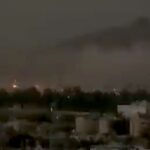On August 29, 2019, Iran failed to launch a satellite, as the “Safir” space launch vehicle (SLV) exploded at Semnan Launch Site One. Commercial satellite imagery published by Planet and Maxar Technologies confirms an explosion on the launch pad. The Iranian government only admits to the “loss of a satellite” and has not addressed the explosion.
The August 29 incident marks the third launch failure of the Iranian Space Agency this year. During a launch attempt in January, Iran lost a “Simorgh” rocket, followed by the explosion of another “Safir” SLV in February. Earlier this month, satellite images confirmed that the Imam Khomeini Space Port (part of the Semnan Launch Site) received a fresh paint job, leading analysts to believe that a new launch is imminent.
President Donald J. Trump mocked the Iranian failure on Twitter and shared declassified geospatial intelligence (GEOINT) of the wreckage site. Critics claim that Trump’s tweet may have leaked a previously unknown deep-look capability of US spatial assets or revealed a clandestine flyover by a US aircraft.
The United States of America was not involved in the catastrophic accident during final launch preparations for the Safir SLV Launch at Semnan Launch Site One in Iran. I wish Iran best wishes and good luck in determining what happened at Site One. pic.twitter.com/z0iDj2L0Y3
— Donald J. Trump (@realDonaldTrump) August 30, 2019
As Iran has significantly improved its air sensor network and aerial defense capabilities, it is unlikely that the US would risk losing another unmanned aerial vehicle. Recently, Iran unveiled a new foreign-inspired long-range surface-to-air missile (SAM) system (“Bavar 373”), which was tested near the Semnan Launch Site. The Bavar 373 was likely deployed to provide area air defense for the formerly undefended space facility. The US’ very high resolution GEOINT was therefore likely collected by either a low-Earth orbit satellite or the U-2 spy plane “Dragon Lady”. Defense journalist Babak Taghvaee has pointed towards the Central Intelligence Agency’s (CIA) KH-12 Block IV as Trump’s “eye in the sky.”
#US President #Trump tweeted this image of #Semnan Launch Site One (where the Safir SLV exploded yesterday) to tell #Iran‘s Islamic Regime that #US is monitoring their every single move. This image is taken by one of three #LockheedMartin KH-12 Block IV spy satellites of #CIA. pic.twitter.com/li6mNl6Xpr
— Babak Taghvaee (@BabakTaghvaee) August 30, 2019
Why is the US Intelligence community interested in Iran’s space program?
As SLV technology is interchangeable with ballistic missiles, there are concerns that Iran’s space program is intended to increase the range of Iran’s ballistic missiles. Classified sources indicate that the first stage of the ill-fated “Safir” SLV is based on Iran’s “Shahab 3” medium range ballistic missile (MRBM). The same sources suggest that the SLV’s second stage is inspired by a North Korean variation of the Soviet-made R-27 (NATO Reporting name SS-N-6), which Iran acquired from Pyongyang.
- Russia Bombs Maternity Ward & Children’s Hospital in Mariupol As Part of Siege - 10 March 2022
- T-Intell’s OSINT Training Marks One Year Anniversary - 18 November 2021
- IS-K Never Left the Battlefield - 27 August 2021





